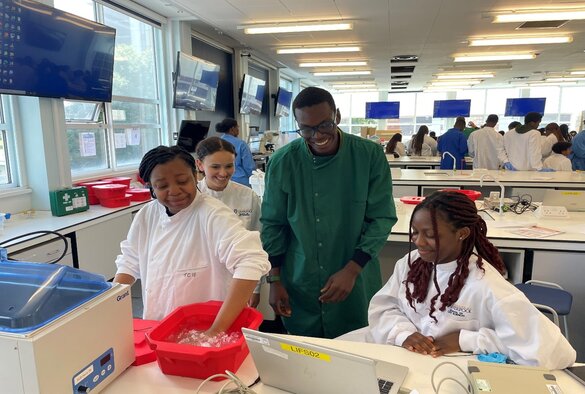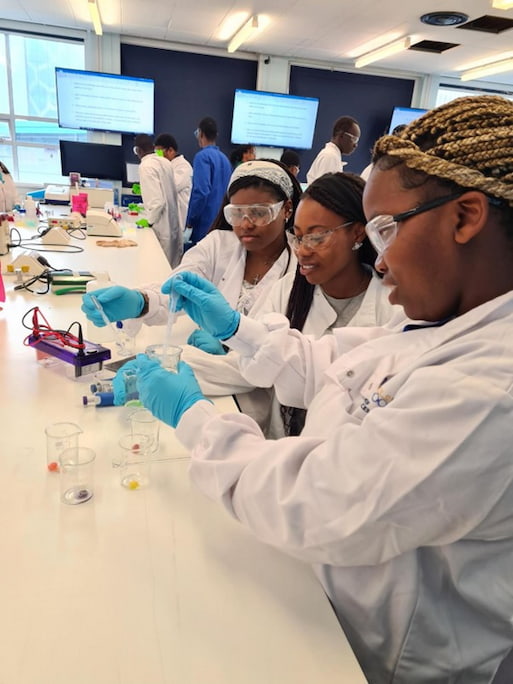Faculty hosts Black Science Bootcamp 2023

Earlier this month, the Faculty of Health and Life Sciences ran a two-day residential for fifty-five black year 10 pupils from local Liverpool schools. Funded by the Faculty’s Equality, Diversity and Inclusion (EDI) Fund, its aim was to help young black people in Liverpool consider university as an option.
Organised by Amal Abdulkadir from Careers and Employability and Dr. Carl Larsen from the School of Life Sciences, the ethos of the summer school was ‘It's hard to be what you can’t see’, and with its focus on representation, virtually all sessions were led by Black STEMM students, academics or professionals. It was hoped that this will help address other issues in higher education for black students including retention, the awarding gap, and progression onto postgraduate study and STEMM careers.
Some of the students who attended the bootcamp were from economically disadvantaged parts of Liverpool and had no siblings at university or parents who had attended university. Informal feedback from the students was they “didn’t want the bootcamp to end”, “can we do it next year”, “10 out 10” and “I now want to study science at university.” The pupils really engaged with the sessions and the overall atmosphere was one of positivity and achievement.
On the first day, pupils took part in scientific experiments including electrophoresis and measuring physiological responses. This was led by undergraduate students Kodie McDonald and Obimobi Onyeukwu-Onyenso and supported by Dr Carl Larsen and Dr Terry Gleave. They visited the William Henry Duncan Building to use the specialised human anatomy labs with Dr Kris D’Aout and PhD student Kiran Riasat.

Students taking part in an electrophoresis practical
Students received tours of our research facilities including NMR with PhD student Genna Ali Abdullah talking about her research and journey into higher education. Students visited the cancer research labs where Professor Joseph Slupsky and PhD student Jayden Gittens talked about their research and showed them cancer cell lines in the specialist microscopy unit. Students also visited the Centre for Cell Imaging and saw demonstrations of the microscopes there with Dr.Marco Marcello. Finally, they visited the GeneMill and watched a demonstration by Dr Enrique Salcedo-Sora on using robotics in cellular and molecular research.
The summer school was organised in collaboration with Lucy Tomlinson (Race Equity Manager) and Samia Benbrih (ED&I manager) from the Liverpool School of Tropical Medicine (LSTM). The students were given a tour of LSTM’s snake venom milking unit by Professor Nick Casewell and Senior Herpetologist Paul Rowley, and Dr Frank Tianyi and Dr Taline Kazandjian delivered research and careers talks.
PhD students Rugare Maruzani, Muhamed Negedu, and Kiran Riasat acted as demonstrators during the summer school and also talked about their experience as PoC in science and higher education. Pupils also got to hear from Ada Onyeukwu-Onyenso about what life is like as a sixth form student studying science. Oluwatobi Adegbite, a postdoctoral researcher also discussed his research and career to date.
Amal Abdulkadir discussed with the pupils potential careers in STEMM and preparing for university. Carl Larsen then spoke about the history of science that is often untold in a session called ‘The Snide Side of Science’ and how to recognise and overcome barriers for females and black people in STEM. Students also visited the Harold Cohen Library to see the facilities and an exhibit on Decolonising Science created by students from Life Sciences.
Carl Larsen commented “Both Amal and I would like to thank all the staff who supported the summer school. The work is very important to us, but we recognise that its success is dependent on having supportive colleagues who care. We plan to apply for central university funding in order to create a package of ongoing support for the students who attended this bootcamp. We’d like to invite them back in 2024, along with another cohort of year 10 pupils.”